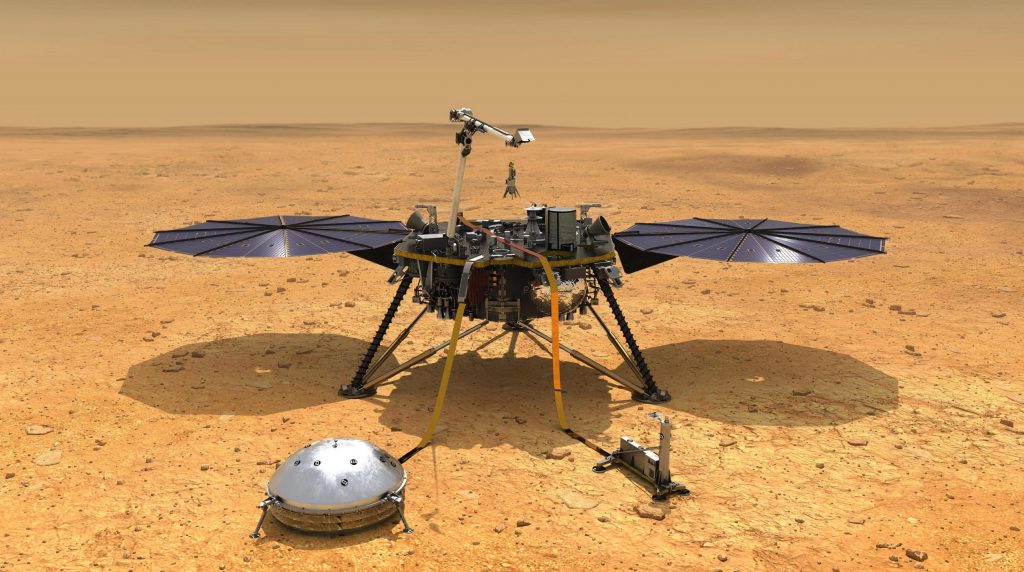The magnitude 3.3 and 3.1 temblors originated in a region called Cerberus Fossae, further supporting the idea that this location is seismically active.

NASA’s InSight lander has detected two strong, clear quakes originating in a location of Mars called Cerberus Fossae – the same place where two strong quakes were seen earlier in the mission. The new quakes have magnitudes of 3.3 and 3.1; the previous quakes were magnitude 3.6 and 3.5.
InSight has recorded over 500 quakes to date, but because of their clear signals, these are four of the best quake records for probing the interior of the planet.
Studying marsquakes is one way the InSight science team seeks to develop a better understanding of Mars’ mantle and core. The planet doesn’t have tectonic plates like Earth, but it does have volcanically active regions that can cause rumbles.
The March 7 and March 18 quakes add weight to the idea that Cerberus Fossae is a center of seismic activity.
“Over the course of the mission, we’ve seen two different types of marsquakes: one that is more ‘Moon-like’ and the other, more ‘Earth-like,’” said Taichi Kawamura of France’s Institut de Physique du Globe de Paris, which helped provide InSight’s seismometer and distributes its data along with the Swiss research university ETH Zurich.
Earthquake waves travel more directly through the planet, while those of moonquakes tend to be very scattered; marsquakes fall somewhere in between. “Interestingly,” Kawamura continued, “all four of these larger quakes, which come from Cerberus Fossae, are ‘Earth-like.’”
The new quakes have something else in common with InSight’s previous top seismic events, which occurred almost a full Martian year (two Earth years) ago: They occurred in the Martian northern summer.
Scientists had predicted this would again be an ideal time to listen for quakes because winds would become calmer. The seismometer, called the Seismic Experiment for Interior Structure (SEIS), is sensitive enough that, even while it is covered by a dome-shaped shield to block it from wind and keep it from getting too cold, wind still causes enough vibration to obscure some marsquakes. During the past northern winter season, InSight couldn’t detect any quakes at all.
“It’s wonderful to once again observe marsquakes after a long period of recording wind noise,” said John Clinton, a seismologist who leads InSight’s Marsquake Service at ETH Zurich. “One Martian year on, we are now much faster at characterizing seismic activity on the Red Planet.”
Better Detection
The winds may have quieted down, but scientists are still hoping to improve their “listening” capability even more. Temperatures near the InSight lander may swing from almost minus 148 degrees Fahrenheit (minus 100 degrees Celsius) at night to 32 degrees Fahrenheit (0 degrees Celsius) during the day.
These extreme temperature variations may be causing the cable connecting the seismometer to the lander to expand and contract, resulting in popping sounds and spikes in the data.
So the mission team has begun trying to partially insulate the cable from the weather. They’ve started by using the scoop on the end of InSight’s robotic arm to drop soil on top of the domed Wind and Thermal Shield, allowing it to trickle down onto the cable. That allows the soil to get as close to the shield as possible without interfering with the shield’s seal with the ground. Burying the seismic tether is in fact one of the goals of the next phase of the mission, which NASA recently extended by two years, to December 2022.
Despite the winds that have been shaking the seismometer, InSight’s solar panels remain covered with dust, and power is running lower as Mars moves away from the Sun. Energy levels are expected to improve after July, when the planet begins to approach the Sun again.
Until then, the mission will successively turn off the lander’s instruments so that InSight can hibernate, waking periodically to check its health and communicate with Earth. [JPL]
Now subscribe to this blog to get more amazing news curated just for you right in your inbox on a daily basis (here an example of our new newsletter).
You can also follow us on Facebook and/ or Twitter. And, by the way you can also make a donation through Paypal. Thank you!
You should really subscribe to QFiles. You will get very interesting information about strange events around the world.













